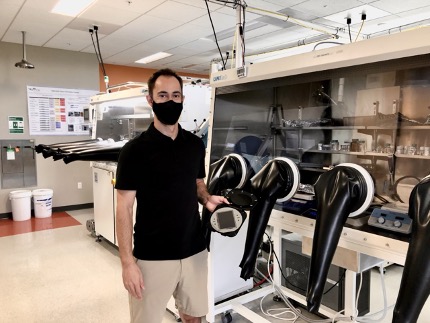Local tech startup continues breakthrough success in global display industry

Mattrix CEO and founder, Max Lemaitre, displays new, full-color OLED display prototype in one of the Mattrix Technologies labs located in The Hub.
The latest generation of top-of-the-line smartphones from Apple and Samsung feature vibrant, high-contrast, organic light-emitting diode (OLED) displays that put the older LCD technology to shame. While these beautiful displays are becoming more commonplace in small mobile devices, high costs have prevented the technology from being widely adopted for larger screens found in laptops, monitors, and TVs. Now Mattrix Technologies has found a way to use technology invented at UF to reduce OLED manufacturing costs for large screens and bring these incredible displays to a wider market.
First developed in Dr. Andrew Rinzler’s lab in the UF Department of Physics, the core technology behind Mattrix’s solution is an organic light emitting transistor (OLET) that simplifies the pixel structure of OLED displays. OLED screens generate brighter, higher-quality images than the more-common LCD screens, but their use has been limited to smaller products, such as newer smart phones, because they are extremely difficult and expensive to manufacture.
“[OLET] technology would change that and allow more of these incredible displays to be accessible to the wider market,” says Max Lemaitre, CEO and founder of Mattrix, which has woven itself into the UF Innovate ecosystem since its inception in 2018.
The technology makes large-scale production of OLED screens more cost-effective by allowing manufacturers to produce OLED displays using fabrication facilities already in place for LCD screen production.
Lemaitre attributes much of the company’s success to its strong ties with UF. In addition to licensing technology from UF Innovate, Mattrix benefited from UF-sponsored research, guidance and funding from UF Innovate | Ventures, and the entrepreneurship program and lab space provided at UF’s mixed-use business incubator, The Hub.
“Mattrix’s technology is a game-changer, and the company’s success is a picture of what the innovation ecosystem at UF and UF Innovate is intended to do for startups,” said Jim O’Connell, assistant vice president of commercialization and leader of UF Innovate. “It all started with an idea in a UF lab, and I fully expect it to change the world.”
In general, hardware tech companies such as Mattrix have had limited success in the United States outside of Silicon Valley due to extremely high start-up costs and industry domination abroad. Investments from Samsung, JSR Corporations, and local funds have allowed Mattrix to continue building traction in the display industry, including the production of its recently unveiled full-color OLED display.
“It’s not easy for a hardware start-up like ours compete against the large incumbents in our industry, and even less so outside of Silicon Valley, but we’ve been able to leverage contact points to the local business ecosystem to maximize our chances,” says Lemaitre. “Our success is truly made possible by this incredible ecosystem that has sprung up around the University of Florida.”
After developing the OLET technology in Professor Rinzler’s lab and moving off campus as a resident client at UF Innovate | The Hub, Mattrix has remained intricately connected to the commercialization arm of UF and the broader business network in Gainesville. Following initial investments from the Samsung Ventures and Japanese materials company, JSR Corporation, Mattrix was one of the first investments by UF’s venture fund, directed by UF Innovate | Ventures.
“We are very excited to be an investor in Mattrix. The company has enormous market potential,” said Jackson Streeter, MD, director of UF Innovate | Ventures.
Mattrix also received matching funds through the Florida High Tech Corridor, an organization that aims to grow the high-tech industry in Central Florida. Most recently, Mattrix was also the first company to receive investments from the Gainesville Tech Fund, organized by venture capital firm Kirenaga.
Mattrix also remains tied to UF through its personnel. Many of the company’s employees are UF graduates or affiliates, including Lemaitre, CFO Bo Liu, and Chief Scientific Advisor Andrew Rinzler. The company has even sourced several interns from the Semiconductor Career Readiness Organization, an undergraduate club on campus.
“Mattrix Technologies is a model of what we hope to achieve here at UF Innovate | The Hub,” said Karl LaPan, director of the incubator. “They were born from research at the university and have consistently utilized all that UF and the broader Gainesville community have to offer.”
Currently, Mattrix is using several small display prototypes to demonstrate proof-of-concept for mobile and TV applications. Looking forward, the company plans to work with display manufacturers to demonstrate their technology on an R&D pilot manufacturing line, while continuing to develop OLET technology for flexible and transparent OLED displays. Mattrix will pursue these efforts while continuing its close relationship with the university and the UF Innovate system.
About Mattrix Technologies
Founded in 2018, Mattrix Technologies is a semiconductor device company developing a breakthrough pixel architecture for flat-panel displays. The company has pioneered its revolutionary OLET (organic light-emitting transistor) technology to enable the cost-effective production of large-area displays.
OLET is a new paradigm for emissive displays that solves the backplane challenges that have limited the adoption of AMOLED displays. At the heart of this breakthrough is a proprietary pixel architecture that combines the drive transistor, storage capacitor and light-emitting layers into a single element. This enables a full-aperture, bottom emission display that simplifies the manufacturing process, increases product lifetime and panel brightness.
For more information about Mattrix Technologies, please visit www.mattrix.com
